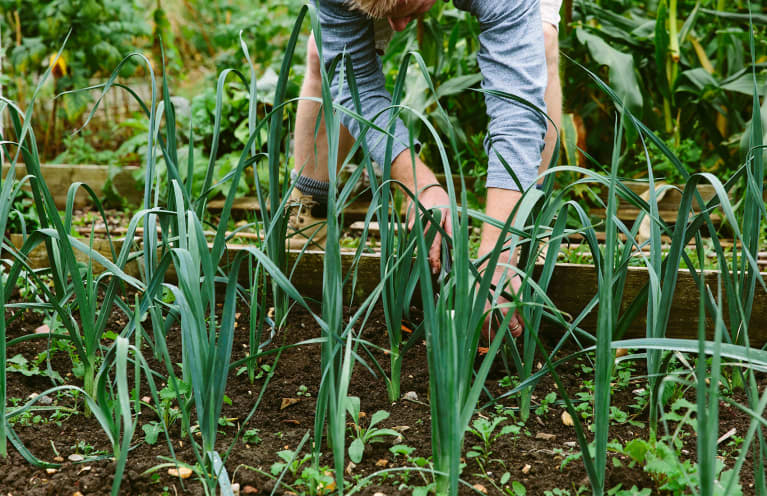Weeds Don't Stand A Chance Against These 7 DIY Natural Weed Killers
They're all 3 ingredients or less.


Our editors have independently chosen the products listed on this page. If you purchase something mentioned in this article, we may earn a small commission.
April 18, 2022 — 11:22 AM
They say beauty is pain, and when it comes to gardening, this popular phrase resonates with many hobbyists and horticulturists. Beautiful blooms and picturesque landscapes don’t come without hard work. And for the most part, those who garden all have one major obstacle to overcome: weeds.
Most garden weeds start by seed, according to Tasha Greer, an Epicurean homesteader and author of Weed-Free Gardening: A Comprehensive and Organic Approach to Weed Management. “However, some also spread from one area to another by runners on top of soil or rhizomes under soil,” Greer tells mbg. While some weeds may be dormant or die back in the winter, they can regrow in spring or summer.
“The main culprits that cause weeds to suddenly break dormancy and grow like crazy are soil disturbance, bare or underplanted soil, insufficient water, poor drainage, sudden changes in soil temperature, and over-fertilization," Greer adds.
In other words, weeds are everywhere, waiting to happen! And beyond being an eyesore, weeds can impact the overall health of your garden over time. “If allowed to become established, they can rob cultivated plants of resources like soil nutrients, water, and light," says Greer. "Some weeds can even influence long-term soil health by encouraging populations of certain bacteria or fungi to increase. Those fungi and bacteria can then alter the soil pH and nutrient availability, endangering even well-established perennials like shrubs and trees.”
Fret not, though. There are ways to combat weeds at home. And while the first instinct for those who don’t want to buy harsh conventional treatments may be to turn to apple cider vinegar, that's far from your only option.
DIY recipes to try at home.
Here, gardening experts share their top homemade recipes for DIY weed killers that are easy to make and safe for the environment.
1. White Vinegar DIY Weed Killer Recipe
This recipe is effective for a few reasons, gardening expert Erinn Witz tells mbg. “The vinegar contains acetic acid, which is caustic to plant cells. The Epsom salt dehydrates the plant by blocking it from absorbing moisture. And the dish soap acts as a surfactant that allows the vinegar and salt to better penetrate the plant tissue.”
2. Boiling Water DIY Weed Killer Recipe
“Boiling water works through simple heat damage,” explains Witz. “The hot water essentially ‘cooks’ the plant cells, resulting in death. This is another indeterminate plant killer, so be careful around plants you want to keep.”
3. Diluted Rubbing (Isopropyl) Alcohol DIY Weed Killer Recipe
“The alcohol dries out the plant tissues, leading to fatal dehydration,” says Witz. “The effects of rubbing alcohol are best on a warm, sunny day, when the sunlight can add its own drying effect.”
4. Vodka DIY Weed Killer Recipe
Witz tells mbg, “The vodka acts as a drying agent, depriving the plant of the moisture it needs to live. When the plant cells get too dehydrated, they die. This is especially effective for broadleaf weeds, and it won't harm grass as much as some other weed killers will.”
5. Dry Baking Soda DIY Weed Killer Recipe
“The baking soda works by sucking moisture from the plant tissues, drying the plant up to the point where it can no longer photosynthesize its food,” says Witz. “This treatment works best on driveways and sidewalks or other hard surfaces where weeds like to pop through the smallest of cracks.”
6. Cornmeal Gluten Meal DIY Weed Killer Recipe
Rodger St. Hilaire, founder and editor of Gardening Boost, suggests this recipe because “the cornmeal gluten meal will prevent weed seeds from germinating.” He notes that it’s important to “make sure to purchase cornmeal gluten meal that is specifically labeled for use on lawns and gardens. Some products are not meant for this purpose and can actually harm your plants.”
7. Borax DIY Weed Killer Recipe
“This is called a cut-and-paste method and is best applied to large semi-woody weeds like thistles,” Brody Hall, a Certified Horticulturist, Certified Conservationist and Land Manager, and Co-Founder at The Indoor Nursery, tells mbg. Borax has a high pH value and it is alkaline enough to kill weeds (as well as other plants, so be careful where you put it).
Preventing weeds in the future.
Once you’ve weeded out the nuisance, you’ll want to take precautions to prevent more weeds from forming. Retired landscaper and lawn care expert Larry Yeates shares his tips with mbg below:
By knowing what causes weeds and how to combat and prevent them, you’ll be on your way to the garden of your dreams, even if you’re new to gardening. Maybe your newfound expertise will inspire you to start a permaculture garden or dig deeper into plant care. Whichever stepping stones you take, the path looks lush.
Want to learn how feng shui can help you create a high-vibe home and set powerful intentions to manifest your dreams? This is feng shui the modern way - no superstitions, all good vibes. Click here to register for a free session with Dana that will give you 3 tips to transform your home today!
Reset Your Gut
Sign up for our FREE doctor-approved gut health guide featuring shopping lists, recipes, and tips
You are now subscribed
Be on the lookout for a welcome email in your inbox!
https://www.mindbodygreen.com/articles/natural-weed-killer

 Kass
Kass 
































